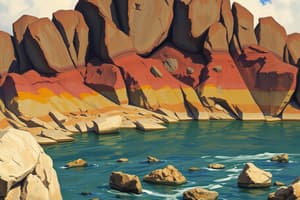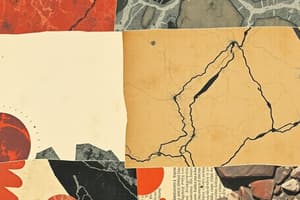Podcast
Questions and Answers
What primarily composes igneous rocks?
What primarily composes igneous rocks?
- Sediments from other rocks
- Recrystallization due to heat and pressure
- Organic materials and minerals
- Magma cooling and crystallization (correct)
Which of the following best describes volcanic (extrusive) igneous rocks?
Which of the following best describes volcanic (extrusive) igneous rocks?
- They undergo chemical alteration due to pressure.
- They are created from cooled lava on Earth's surface. (correct)
- They form from the lithification of sediments.
- They form deep underground with a coarse texture.
What type of rock is basalt categorized as?
What type of rock is basalt categorized as?
- Volcanic extrusive igneous rock (correct)
- Sedimentary rock
- Metamorphic rock
- Plutonic igneous rock
How do plutonic (intrusive) igneous rocks typically form?
How do plutonic (intrusive) igneous rocks typically form?
Which of the following statements about granite is accurate?
Which of the following statements about granite is accurate?
What distinguishes a dike from a sill in igneous rocks?
What distinguishes a dike from a sill in igneous rocks?
What is the primary engineering property of granite?
What is the primary engineering property of granite?
What term refers to the formation process of sedimentary rocks?
What term refers to the formation process of sedimentary rocks?
What is the range of resistance that igneous rocks must have to be used in material engineering services?
What is the range of resistance that igneous rocks must have to be used in material engineering services?
Which of the following types of sedimentary rocks is formed by the cementation process?
Which of the following types of sedimentary rocks is formed by the cementation process?
What does the term 'consolidation' refer to in the context of sedimentary rock formation?
What does the term 'consolidation' refer to in the context of sedimentary rock formation?
Which of the following describes the process of compaction in sedimentary rock formation?
Which of the following describes the process of compaction in sedimentary rock formation?
What causes the degradation of igneous rocks, affecting their credibility?
What causes the degradation of igneous rocks, affecting their credibility?
Which of the following statements about sedimentary rocks is NOT correct?
Which of the following statements about sedimentary rocks is NOT correct?
Which sedimentary rock is primarily known for being formed by crystallization?
Which sedimentary rock is primarily known for being formed by crystallization?
Why is it important to inspect volcanic rocks before construction?
Why is it important to inspect volcanic rocks before construction?
What is the primary component of diorite?
What is the primary component of diorite?
Which of the following igneous rocks is most abundant?
Which of the following igneous rocks is most abundant?
What characteristic texture is formed by slow cooling of magma?
What characteristic texture is formed by slow cooling of magma?
What is the compressive strength of granite on average?
What is the compressive strength of granite on average?
Which mineral is least likely to be present in syenite?
Which mineral is least likely to be present in syenite?
What is a key property of plutonic rocks?
What is a key property of plutonic rocks?
What distinguishes obsidian from granite despite their same chemical composition?
What distinguishes obsidian from granite despite their same chemical composition?
What is the term used to describe the size, shape, and arrangement of mineral grains in a rock?
What is the term used to describe the size, shape, and arrangement of mineral grains in a rock?
What characteristic defines foliated metamorphic rocks?
What characteristic defines foliated metamorphic rocks?
Which metamorphic process is specifically associated with mountain building?
Which metamorphic process is specifically associated with mountain building?
What is the primary mineral composition of quartzite?
What is the primary mineral composition of quartzite?
Which type of metamorphism is driven by temperature changes within the host rock?
Which type of metamorphism is driven by temperature changes within the host rock?
What causes the foliation in metamorphic rocks?
What causes the foliation in metamorphic rocks?
Which of the following is a non-foliated metamorphic rock?
Which of the following is a non-foliated metamorphic rock?
What happens if the melting point of a rock is reached during metamorphism?
What happens if the melting point of a rock is reached during metamorphism?
Which of the following best describes hydrothermal metamorphism?
Which of the following best describes hydrothermal metamorphism?
What is the main reason foliated metamorphic rocks are not preferred as construction materials?
What is the main reason foliated metamorphic rocks are not preferred as construction materials?
Which of the following characteristics makes marble ideal for building materials?
Which of the following characteristics makes marble ideal for building materials?
What can be a significant hazard when constructing in schist-rich regions?
What can be a significant hazard when constructing in schist-rich regions?
In what way do metamorphic rocks respond to favorable climatic conditions?
In what way do metamorphic rocks respond to favorable climatic conditions?
What is a significant factor regarding massive gneisses in construction?
What is a significant factor regarding massive gneisses in construction?
What issue can arise from schistosized and competing gneisses in construction?
What issue can arise from schistosized and competing gneisses in construction?
What effect do clay minerals have on the strength of foliated metamorphic rocks?
What effect do clay minerals have on the strength of foliated metamorphic rocks?
What is a common characteristic of metamorphic rocks that affects their use in construction?
What is a common characteristic of metamorphic rocks that affects their use in construction?
Flashcards are hidden until you start studying
Study Notes
Introduction to Rocks
- Rocks are aggregates of mineral particles and can include organic materials.
- Minerals serve as the fundamental components of rocks.
- Geological layers include: Bedrock → Outcrop → Regolith → Soils.
Rock Classification
- Igneous Rocks: Formed from the cooling and crystallization of magma.
- Sedimentary Rocks: Created through lithification of sediments from other rocks.
- Metamorphic Rocks: Result from recrystallization due to heat, pressure, and chemical alteration.
Igneous Rocks
- Volcanic (Extrusive) Igneous Rocks: Form on Earth's surface where lava cools, e.g., basalt.
- Basalt is dark and fine-grained, prevalent on ocean floors.
- Plutonic (Intrusive) Igneous Rocks: Form deep underground as magma cools slowly, e.g., granite.
- Granite is the most common plutonic rock, coarse-grained and often light-colored.
- Hypabyssal Rocks: Form close to the surface in sheet-like bodies called sills or dykes.
Sills and Dikes
- Sill: An igneous layer that runs parallel to rock strata; can vary in thickness.
- Dike: A vertical igneous body that cuts across rock layers; varying thickness from a few centimeters to several meters.
Common Igneous Rocks
- Granite: Light-colored, coarse-grained; contains feldspar and quartz.
- Known for hardness, frost resistance, and compressive strength (average 24,500 psi).
- Used in structural applications, such as flooring tiles.
- Diorite: Coarse-grained intrusive rock made of plagioclase feldspar and hornblende.
- Used primarily for decorative purposes.
- Syenite: Contains primarily potassium feldspar (80-85%); rare in commercial use.
Texture of Igneous Rocks
- Texture refers to the size, shape, and arrangement of mineral grains.
- Types include coarse-crystalline, fine-grained, cryptocrystalline, and glassy.
- Cooling rates impact texture: slow cooling leads to crystallization, while rapid cooling results in glassy textures.
Importance of Igneous Rocks in Engineering
- Plutonic rocks offer high resistance to breakage and pressure, suitable for engineering applications.
- Volcanic rocks have variable physical properties; thorough inspection necessary for construction use.
- Degrading volcanic tuffs and breccias can undermine structural integrity.
Sedimentary Rocks
- Formed from layers of sediments deposited in bodies of water, covering 70-80% of Earth's land area.
- Lithification processes: compaction, cementation, and crystallization convert loose sediments into hard rocks.
- Common sedimentary rocks include limestone, shale, sandstone, and conglomerate.
Types of Metamorphism
- Contact Metamorphism: Caused by an increase in temperature due to nearby hot magma.
- Regional Metamorphism: Related to mountain-building activities.
- Burial Metamorphism: Occurs deep beneath thick sedimentary layers.
- Hydrothermal Metamorphism: Involves chemical changes from hot, ion-rich waters.
Metamorphic Rock Textures
- Foliated Rocks: Display parallel bands of minerals, formed under directional pressure.
- Non-foliated Rocks: Lack layered texture, formed under minimal stress.
Key Metamorphic Rocks
- Slate: Forms from shale under heat and pressure, has fine layers and easily splits.
- Schist: Features shiny layers due to platy minerals.
- Gneiss: Exhibits bands of light and dark minerals from granite.
- Marble: Result of limestone recrystallization.
- Quartzite: Formed from the transformation of sandstone into a dense quartz mass.
Engineering Properties of Metamorphic Rocks
- Foliated rocks are generally weak for construction due to mineral alignment along planes.
- Marble is favored for building materials due to stability and aesthetics.
- Massive gneisses are suitable for various large underground constructions, while schist poses risks for stability in excavations.
Rock Recycling
- The rock cycle is a continuous process where rocks are transformed into different types over geological time.
Studying That Suits You
Use AI to generate personalized quizzes and flashcards to suit your learning preferences.




